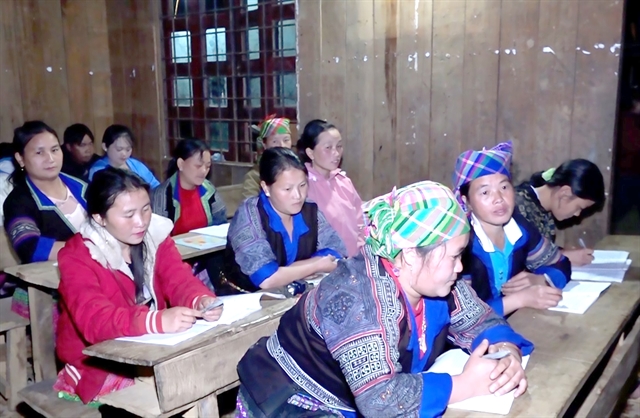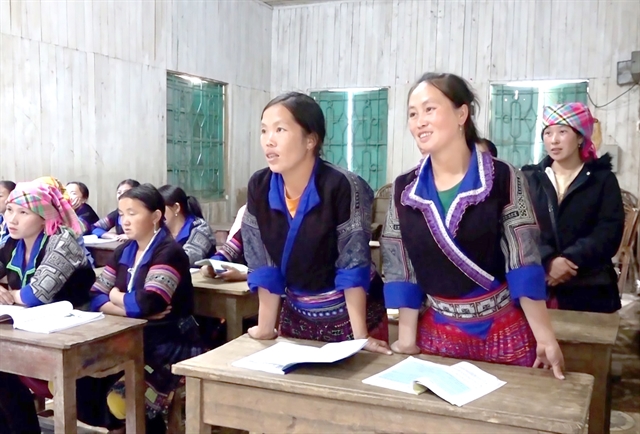 Society
Society

 |
| An illiteracy eradication class in Thào Xa Chải Village, Nậm Có Commune, Mù Cang Chải. — VNA/VNS Photos Tiến Khánh |
YÊN BÁI — Every evening, lights in illiteracy eradication classes in many localities in Mù Cang Chải District, Yên Bái Province, shine brightly, supporting teaching and learning efforts of teachers and students.
In a quiet space, the voices of adult students reading words echo in unison among the mountains and forests, lighting up their hope for a bright tomorrow.
Realistic benefit
Working in the field during the day and studying at night has become an indispensable routine and schedule for the people in Thào Xa Chải and Tà Ghênh villages, Nậm Có Commune, Mù Cang Chải District.
Overcoming their shyness, they try to spell each word in unison.
Even though their voices reading Vietnamese are not yet full and clear, they all boldly read aloud under the teacher's guidance.
Thào Thị Mỷ, 46, who lives in Tà Ghênh Village, excitedly says that in the past she did not know how to read and write Vietnamese.
She was afraid of communicating and had difficulty when going out.
“Now I can learn, have teachers guide me in reading books and magazines, and use the Internet. I gradually know many good things from outside, and know how to eliminate outdated customs, so I try even harder to go to class,” says Mỷ.
In addition to Mỷ, the class has 19 other students who are ethnic Mông people in Nậm Có Commune.
Each person is of a different age, but they have one thing in common: they are illiterate and not fluent in Vietnamese.
Therefore, they are afraid to do anything related to official documents, including not registering birth certificate for their children.
Being illiterate, they sometimes commit illegal acts without knowing it.
Chang A Của, a 38-year-old student from Thào Xa Chải Village, says that illiteracy makes it difficult to do anything.
“I work in the tourism sector but don't know Vietnamese, which is very inconvenient. I am determined to go to the class so that I can work at a homestay and be able to introduce my homeland and traditional customs of the ethnic Mông people to tourists,” says Của.
Going to class, the teacher educates the Party and State's guidelines and policies, which Của sees as his responsibility to his homeland, and at the same time he instructs his children to respect the laws.
Living a farming life all year round since she was a child, Sùng Thị Chù lives in Háng Cháng Lừ Village, Khao Mang Commune, and is over 50 years old but still cannot read or write.
After completing the illiteracy eradication class, her life seemed to enter a new period.
She can read the commune's notices and fill in the medical examination registration herself.
Thanks to her literacy, Chù is more confident in buying seedlings and animals, and can read instructions on applying science and technology in production.
Sùng says that since she could read and write, she has been sent to training classes on healthcare, raising children and building a happy family, planting crops and raising livestock, and preventing and combating women and child trafficking.
From there, she guides other local people in the village.
“Now, I understand everything when I watch television, and can read instructions on how to use medicine when I'm sick. When I go to the commune or district to do administrative procedures, I can write my name, and no longer just press my fingersprints like before,” says Chù.
Efforts
 |
| Learners excitedly join activities in the class. |
Mù Cang Chải District has over 67,000 people, of whom over 90 per cent are ethnic Mông people, living scattered in 98 villages.
Their lives are difficult, and the illiteracy rate is high.
In recent years, the district has continuously opened many classes in the village, creating favourable conditions for locals to learn Vietnamese.
Nguyễn Anh Thủy, head of the district Department of Education and Training, says that in addition to actively encouraging people between the ages of 25-60 to participate in illiteracy eradication classes, the department has assigned qualified teachers with enthusiasm to work on weekday evenings.
The department coordinates with localities and organisations to carefully prepare facilities and teaching equipment for the classes.
Learners now can use Vietnamese, make calculations, have simple and necessary understanding of natural and social issues and have more knowledge to apply to production.
When their education level is raised, it is easier for them to spread the Party and State's guidelines and policies to the people, especially building a new rural living style.
Like many other localities in the area, Nậm Khắt Commune opens two illiteracy eradication classes each year.
Deputy Chairman of the commune People's Committee Lý A Sấu says that it is a difficult task.
Besides preparing facilities for classes, the commune has to go to each house and encourage local people to join.
To help students learn faster, in addition to being enthusiastic and persistent in teaching, teachers must be knowledgeable in the Mông language, and flexible and creative in teaching methods to bring effective and practical results.
Lù Văn Thức, a teacher at the Tà Ghênh Primary School in Nậm Có Commune, says that older students are afraid to go to school, so teachers must teach, talk, and encourage them at the same time.
Teachers also integrate games in the teaching process, creating fun for everyone to compete in learning.
In particular, teachers focus on applying information technology to help students learn more effectively.
Activities create excitement for learners, helping them practise anywhere and anytime.
After much effort, up to now, the literate rate of people between the ages of 15-60 in the district has reached nearly 78 per cent.
Fourteen commune-level units are recognised as meeting literacy standards.
It is expected that this year, the district will open six classes with 180 students in challenging communes. — VNS